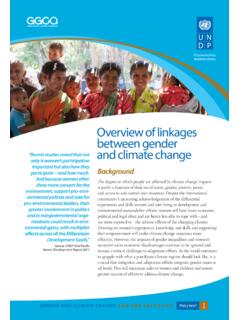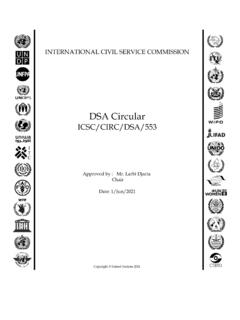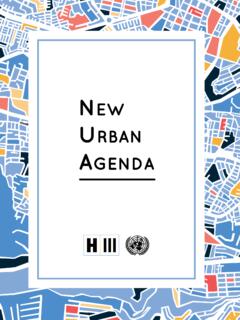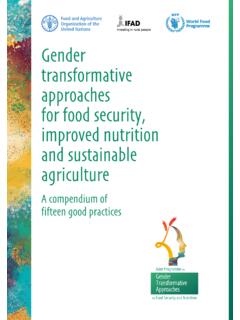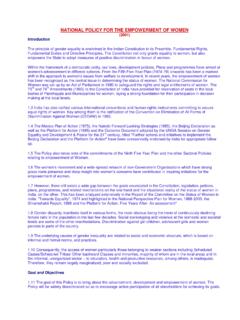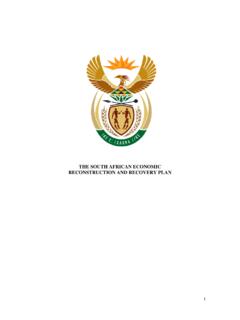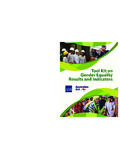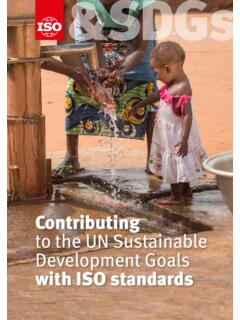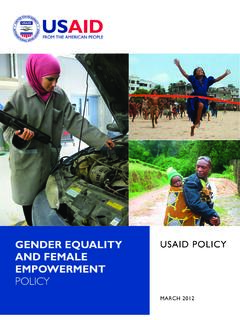Transcription of GENDER AND CLIMATE CHANGE Overview of linkages …
1 GENDER AND CLIMATE CHANGEO verview of linkages between GENDER and CLIMATE changeThe Earth s CLIMATE is changing already and failure to limit warming to below 2 C could make the changes in the CLIMATE system irreversible and characterized by cataclysmic consequences. The adverse impacts of CLIMATE CHANGE continue to overly burden the poorest and the most vulnerable, especially poor women . Despite growing recognition of the differential vulnerabilities as well as the unique experiences and skills women and men bring to development and environmental sustainability efforts, women still have less economic, political and legal clout and are hence less able to cope with and are more exposed to the adverse effects of the changing CLIMATE . On the other hand, women are powerful agents of CHANGE and continue to make increasing and significant contributions to sustainable development, despite existing structural and sociocultural barriers.
2 As the global community transitions to the implementation phase of the post-2015 development agenda, it is imperative that GENDER equality and women s empowerment continue to influence, shape and drive the collective CLIMATE and human development AND CLIMATE CHANGET here can be no genuine sustainable human development without GENDER equalityThe year 2015 marked a number of pivotal achievements for GENDER and sustainable development. An ambitious agenda to guide development action for the next 15 years1 was launched through the 17 Sustainable Development Goals (SDGs), putting a much-needed spotlight on poverty, inequality, and violence against women as key challenges of the 21st century. Similarly, the Sendai Framework for Disaster Risk Reduction 2015 2030, a successor instrument to the Hyogo Framework for Action 2005 2015, incorporated key recommendations on GENDER -sensitive Disaster Risk Reduction (DRR) and promoted a stronger role for women in building resilience.
3 The 2015 Paris Agreement also calls for GENDER equality and women s empowerment , and its provisions on adaptation and capacity-building efforts urge member states to adopt GENDER -responsive approaches. Further, many Intended Nationally Determined Contributions (INDCs) submitted to the United Nations Framework Convention on CLIMATE CHANGE (UNFCCC) as part of the implementation regime of the Paris Agreement reflect GENDER priorities in their pledges for CLIMATE forward, the key question is how to translate the ambitious goals and aspirations set forth in the global (and national) post-2015 sustainable development and CLIMATE platforms into concrete actions that stabilize the Earth s systems and promote human development. GENDER equality and the empowerment of women must shape and drive future development and CLIMATE actions and investments. Box 1 CLIMATE CHANGE and GENDER context: IPCC Differences in vulnerability and exposure arise from non-climatic factors and from multidimensional inequalities often produced by uneven development processes (very high confidence).
4 These differences shape differential risks from CLIMATE CHANGE . (..) People who are socially, economically, culturally, politically, institutionally, or otherwise marginalized are especially vulnerable to CLIMATE CHANGE and also to some adaptation and mitigation responses (medium evidence, high agreement). This heightened vulnerability is rarely due to a single cause. Rather, it is the product of intersecting social processes that result in inequalities in socioeconomic status and income, as well as in exposure. Such social processes include, for example, discrimination on the basis of GENDER , class, ethnicity, age, and (dis)ability. Source: IPCC, Summary for Policymakers , in CLIMATE CHANGE 2014: Part A, p. 633 Overview of linkages between GENDER and CLIMATE changePolicy Brief1 CLIMATE CHANGE can undo decades of developmentClimate CHANGE is perhaps the greatest threat to sustainable development. Earth temperatures have exceeded global annual averages for 39 consecutive years the temperature of Earth for the year 2015 was the hottest in recorded history.
5 According to the Intergovernmental Panel on CLIMATE CHANGE (IPCC), many observed impacts of the changing CLIMATE , such as sea-level rise, are happening more quickly than previously predicted, threatening coastal communities and critical infrastructure by increasing the frequency of disaster events, including flooding and storms. Similarly, the world s two major ice sheets are melting much faster relative to past According to a recent report of the UN Secretary-General, the cost of disasters, mainly CLIMATE -related, has reached an average of $250 billion to $300 billion a year5 during 2003 2013, disasters cost nearly $ trillion in worldwide economic Impacts are being felt in all corners of the world extreme weather events, heatwaves and droughts have increased in frequency and intensity, often with damaging effects to agriculture, fishing and other livelihoods. CLIMATE CHANGE can jeopardize gains made by the global community in important domains such as food security and access to health and the effects of CLIMATE CHANGE on ecosystems and livelihoods vary by region and season, they are harsher on those living in already marginal Moreover, these changes could exacerbate chronic environmental threats (such as deforestation, water scarcity and land degradation) that most affect the For example, around 350 million people, mostly poor, live in or near forests on which they rely for their livelihoods thus, climatic stress on forests could hurt the Similarly, around billion people who live in fragile ecological areas ( , arid zones, on slopes, in areas with poor soils or in forest ecosystems)
6 Continue to see their livelihoods endangered from biodiversity loss exasperated by CLIMATE The poor and other marginalized segments of society are especially vulnerable to CLIMATE CHANGE since their livelihoods are often highly dependent on natural resources that are sensitive to CLIMATE These groups also lack the resources needed to weather harsh climatic impacts ( , better houses, drought resistant crops). This diminished adaptive capacity makes them even more vulnerable, forcing them to engage in unsustainable environmental practices such as deforestation in order to sustain their UNDP Guatemala4 GENDER AND CLIMATE CHANGEBox 2 NDCs An opportunity to revisit national priorities on genderThere has been significant recent progress in elevating GENDER in CLIMATE CHANGE planning at the national and global levels. Global examples include the Green CLIMATE Fund (GCF), which has mandated a GENDER -sensitive approach in its charter and put in place a GENDER policy and a GENDER action plan to guide its operations.
7 At the national level, countries such as Honduras and Peru have prioritized high levels of GENDER integration in their CLIMATE CHANGE policy and planning documents. The latest examples of progress comes from the inclusion of GENDER dimensions in a selection of Intended Nationally Determined Contributions (INDCs), submitted under the United Nations Framework Convention on CLIMATE CHANGE (UNFCCC) in Paris in 2015 (COP 21).14 INDCs are principally pledges for CLIMATE action that represent each member country s assessment of how much they will reduce their greenhouse gas emissions. However, many countries seized the opportunity to embed CLIMATE policies within their broader developmental programmes and priorities. Accordingly, about 40 percent of INDCs explicitly mentioned GENDER and/or women in their national ambitions on CLIMATE CHANGE mitigation most of these countries identify GENDER as a cross-cutting policy priority, or commit to integrating or mainstreaming GENDER into all CLIMATE CHANGE actions, strategies and policies.
8 15 Liberia, Peru and Jordan went a step further and actually reference their GENDER and CLIMATE CHANGE action plans in their INDCs. As countries move into the implementation phase of the Paris Agreement, their Nationally Determined Contributions (NDCs), and other related national adaptation and mitigation instruments, there is a huge potential for embedding GENDER -responsive and GENDER -transformative approaches that promote women s empowerment while also delivering results for zero-carbon and CLIMATE -resilient futures. Like NDCs, other similar instruments such as the national low-emission development strategies and, in the case of adaptation, the National Adaptation Plans (NAPs), provide even more scope and opportunity for mainstreaming GENDER considerations in adaptation and development CHANGE is not GENDER neutralThe poor and marginalized segments in many societies ( women , the elderly, immigrants, indigenous groups, etc.)
9 Are structurally CLIMATE CHANGE impacts men and women differently, largely due to their GENDER -differentiated relative powers, roles and responsibilities at the household and community levels. women tend to be overly burdened with household work and caring for children, the sick and the elderly. For example, during the Asian tsunami in 2004 (70 percent of the victims were women ), many women and children were trapped inside their homes while most men were out in the open. Further, cultural and religious norms on respective GENDER roles sometimes limit women s abilities to make quick decisions in disaster situations and, in some cases, the clothes they wear and/or their responsibilities in caring for children could hamper their mobility in times of Disparities in economic opportunities and access to productive resources also render women more vulnerable to CLIMATE CHANGE because they are often poorer, receive less education, and are not involved in political, community and household decision-making processes that affect their lives.
10 women tend to possess 5 Overview of linkages between GENDER and CLIMATE changePolicy Brief1 Box 3 CLIMATE CHANGE and the GENDER gap Eighty percent of people displaced by CLIMATE CHANGE are women . Globally, women earn 24 percent less than men and hold only 25 percent of administrative and managerial positions in the business world 32 percent of businesses have no women in senior management positions. women still hold only 22 percent of seats in single or lower houses of national parliament. Nine in ten countries have laws impeding women s economic opportunities, such as those which bar women from factory jobs, working at night, or getting a job without permission from their husband. A study using data from 219 countries from 1970 to 2009 found that, for every one additional year of education for women of reproductive age, child mortality decreased by per cent. Two million women and children four a minute die prematurely due to illness caused by indoor air pollution, primarily from smoke produced while cooking with solid fuels.
